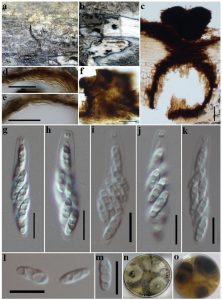Diaporthe eucalyptorum Crous & R.G. Shivas, Persoonia 28: 153 (2012)
Index Fungorum number: IF800374
Saprobic on an unidentified twig. Asexual morph: undetermined. Sexual morph: Stromata immersed, ascomata covered with a blackened zone. Ascomata 432–560 × 422–467 μm (x̅ = 512 × 448), perithecial, globose to subglobose, solitary to gregarious, immersed, lignicolous, coriaceous, immersed, with long necks, periphysate. Necks 1–1.5 cm long, 88–133 μm wide, soft at base, apically carbonaceous, straight, sometimes laterally emerging through host surface, wall consists of textura prismatica. Peridium pale brown to hyaline consisting of textura angularis cell layers. Paraphyses filamentous, sparsely present, septate, unbranched, basally broad, narrowing towards apices, granulate. Asci 38.5–46.9 (50.6) × 7.3–9.8 μm (x̅ = 42.4 × 8.3, n = 25), unitunicate, 8-spored, obclavate, apically flat-ended, with a cylindrical J- apical ring in Lougal’s reagent, apedicellate. Ascospores (8.6) 9.3–10.8 × 2.7–4.4 (4.7) μm (x̅ = 9.9 × 3.5, n = 28), hyaline, uniseriate at apical end and overlapping triseriate at centre and below, oblong, 1-septate, constricted at the septum, with two pseudo-septa, with obtuse ends, smooth-walled.
Culture characteristics – Colonies on malt extract agar cottony, initially white, becoming brown at maturity, circular, centrally brown, 42 mm diameter in one week old culture on malt extract agar medium at 28 °C.
Material examined – India, Andaman and Nicobar Islands, South Andaman, Manjery, (11˚52’68.2.0”N, 92˚64’74.9”E), isolated from an unidentified twig, 17 May 2018, M. Niranjan & V.V. Sarma (PUFNI 17624), living culture, NFCC-4374.
GenBank numbers – ITS: MK990278, LSU: MK981540, SSU: MK981536.
Known distribution (based on molecular data) – Australia, Brazil, China, India, Republic of Korea, Thailand, Turkey and Vietnam (https://www.ncbi.nlm.nih.gov/nuccore).
Known hosts (based on molecular data) – Acampe praemorsa, Acanthus ilicifolius Bruguiera cylindrical, Bruguiera gymnorhiza, Bruguiera sexangula, Cerops tagal, Cocos nucifera, Epidendrum radicans, Eucalyptus sp., Camellia taliensis, Hevea brasiliensis, Ilex cornuta, Lumnitzera racemosa, Mangifera indica, Melia azedarach, Morinda officinalis, Rhizophora mucronata, Rhizophora stylosa, Rhyncostylis retusa, Scyphiphora hydrophyllacea, Sonneratia alba, Vellozia gigantean and Xylocarpus granatum (https://www.ncbi.nlm.nih.gov/nuccore).
Notes – The blast search results of ITS, LSU and SSU of our taxon reveals that it is closely related to Diaporthe species including Diaporthe foeniculina, D. amygdali, D. eucalyptorum, D. musigena, D. foeniculina, D. velata and D. phaseoli. However, our taxon has larger ascomata, smaller asci and ascospores as compared to D. foeniculina. Diaporthe phaseoli has smaller ascomata and asci, and larger ascospores (Niranjan et al. 2018). Diaporthe velata has larger ascomata, asci and ascospores when compared to our taxon (Udayanga et al. 2014). Diaporthe amygdali, D. eucalyptorum and D. musigena have only asexual morph (Dissanayake et al. 2017). Diaporthe eucalyptorum distributed in various countries in many host plants (Schoch et al. 2014, Dissanayake et al. 2017, Deepthi & Ray 2018, Kaliane et al. 2018, Rajamani et al. 2018, Zhou et al. 2018, Manawasinghe et al. 2019, Gao et al. 2020, Zhao et al. 2020). In the phylogenetic analysis, D. eucalyptorum (strain PUFNI 17624) clustered with D. eucalyptorum (strain KACC48653) showing high bootstrap support (ML 96%, BYPP 0.99%). Therefore, this taxon is considered as the sexual morph of Diaporthe eucalyptorum.

Figure 1 – Diaporthe eucalyptorum (NFCC-4374, a new host record). a, b Ascomata. c Vertical section of ascoma. g–k Asci. l–n Ascospores. n, o Culture on malt extract agar plate. Scale bars: c–f = 10 μm, g–m = 10 μm
